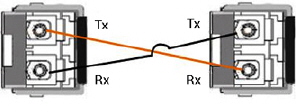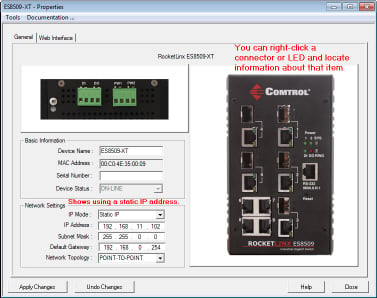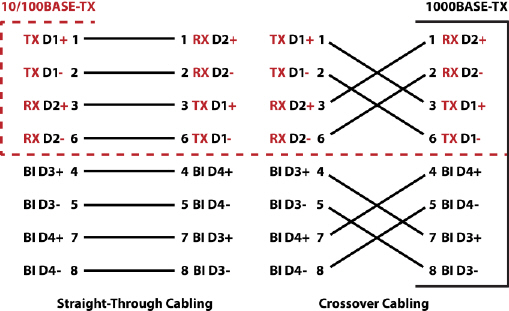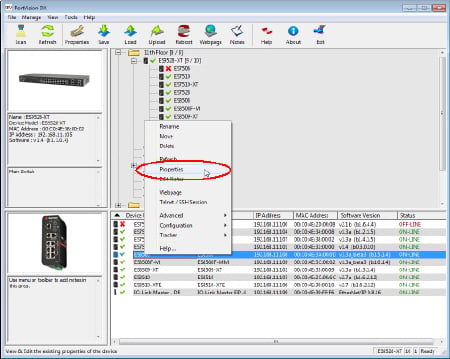
|  | RocketLinx ES7528 Installation OverviewYou can use the following overviews to set up the RocketLinx ES7528.
You can use this installation procedure and the RocketLinx ES7528 User Guide,
which contains detailed installation and configuration information for the ES7528.
Connect the AC power cord between the ES7528 and an AC power source.
Connect the DC power to the ES7528.
The ES7528 provides redundant or aggregated power inputs,
depending on the voltage of the power input.
If there are more than two power inputs connected with different voltages,
the ES7528 is powered from the highest connected voltage (redundant power).
If the voltages of power inputs are the same, the total power output is aggregated.
![[Note]](images/note.gif) | | Note |
|---|
|
Remember to unplug the power terminal block before making wire connections, otherwise the
screwdriver can inadvertently short the terminal connections to the grounded enclosure.
|
|
Insert the wires (12 - 22 AWG) from the power supply into the terminal block connector contacts. Tighten the wire-clamp screws to prevent the wires from coming loose.
The DC1/DC2 LED turns red during the boot cycle and turns green when the unit is ready.
Connect a ground wire between the ES7528 chassis and
earth ground using 12-24AWG wire to ensure that the ES7528 is not damaged by noise or electrical shock.
Loosen the earth ground screw on the right side of the ES7528. Tighten the screw after the earth ground wire is connected.
If desired, connect the Digital or Relay Output.
The relay contacts are energized, (open) for normal operation and close for
fault conditions. The fault conditions include:
Dry output Power failure Link failure Ping failure Super ring failure

Mount the ES7528 into a rack.
Attach the brackets to the ES7528 by using the screws provided in the Rack Mount kit. Mount the ES7528 in a 19-inch rack by using the four rack-mounting screws provided in the kit. When installing multiple switches, mount them in the rack one below the other.
Reserve 0.5U-1U of free space for multiple switches when installing in
high temperature environments. It is important to disperse the heat generated by the ES7528.
![[Note]](images/note.gif) | | Note |
|---|
Temperature: Check if the rack environment temperature conforms to the specified operating temperature range.
Mechanical Loading: Do not place any equipment on top of the switch.
In high vibration environments, additional rack mounting protection may be necessary.
Grounding: Rack-mounted equipment should be properly grounded.
On the back panel of ES7528, there is one earth ground screw.
Loosen the earth ground screw with a screwdriver; then tighten the screw after earth ground wire is connected.
|
|
Connect standard Ethernet cables between the ES7528 Ethernet ports and the network nodes.
Ports 1-24 are 10/100BASE-TX IEEE802.3af (PoE) and IEEE802.3at (PoE Plus)
compliant Ethernet ports. In addition to the 10/100BASE-TX port features, the PoE ports
provide 48VDC at 350mA (maximum 15.4W/port) or provide 53VDC at 606mA (maximum 32W/port),
auto-sensing and automatic power off when cables are removed.
The following table shows the RJ45 PoE pin-out assignment.
The Fast Ethernet ports (Ports 1-24) support 10BASE-T and 100BASE-TX,
full- or half-duplex modes. All of the Ethernet ports auto-detect the signal from connected devices
to negotiate the link speed and duplex mode. Auto MDI/MDIX allows you to connect another switch, hub, or
workstation without changing straight-through or crossover cables.
Crossover cables cross-connect the transmit lines at each end to the received lines at the opposite end.
Ports 25-28 are Gigabit (1000BASE-TX) Combo RJ45/SFP ports.
Always make sure that the cables between the switch and attached devices (for example, switch, hub, or workstation)
do not exceed 100 meters (328 feet).
10BASE-T: Category 3, 4, or 5 cable 100BASE-TX: Category 5 cable 1000BASE-TX: Category 5 or 5e cable IEEE 802.3af: Category 5 cable IEEE 802.3at: Category 5e or 6 cable
Optionally, connect the SFP transceivers. To ensure system reliability,
Pepperl+Fuchs Comtrol, Inc. recommends using
Comtrol
certified SFP transceivers.
Cross-connect the transmit channel at each end to the receive channel at the opposite end.
The ES7528 equips four Gigabit SFP ports combined with Gigabit Ethernet ports. The SFP ports supports
1000BASE-SX/LX/LHX/XD/ZX. The SFP ports accept standard mini GBIC SFP transceivers.

![[Note]](images/note.gif) | | Note |
|---|
This is a Class 1 Laser/LED product. Do not stare at the Laser/LED Beam. |
|
The SFP port does not function until the fiber cable is linked to another active device.
When the SFP module is plugged in and there is no active connection (link) on the fiber, then
the Gigabit port will link.
The SFP and corresponding RJ45 ports work in an exclusive mode.
Traffic sent or received through the SFP module will have priority thus no traffic will be sent
or received over the corresponding RJ45 connection. To use the RJ45
connection, remove the corresponding SFP module.
Plug the SFP transceiver into the SFP fiber transceiver. Connect the transmit channel to the receive channel at each end. Check the direction/angle of the fiber transceiver and the fiber cable.
Verify that the LEDs display that it is ready to configure the IP address.
The Link/Act LED is lit when the cable is correctly connected.
Configure the IP address using one of the following methods:
The easiest way to configure a static IP address for your network in the ES7528 is to use a
Windows host and PortVision DX (see Programming the IP Address).
For information about using other configuration methods,
refer to the RocketLinx ES7528 User Guide.
Programming the IP AddressThe following procedure uses PortVision DX to program an IP address. Other network configuration methods are discussed in
the RocketLinx ES7528 User Guide.
Install PortVision DX
on a host system with a Windows operating system.
If you need assistance using PortVision DX, see the help system or the
PortVision DX User Guide. Start PortVision DX. PortVision DX can be started from
Start --> All Programs --> Comtrol --> PortVision DX. Click the Scan button. Select the Pepperl+Fuchs Comtrol, Inc. product families that you want to locate and
click the Scan button.
Configure the ES7528 IP address for your network.
Right-click the ES7528 in the Device List (lower)
or Device Tree (upper) pane that you want to configure and click Properties.
Enter a user-friendly Device Name, which displays a friendly device
name on the main page.
 Optionally, enter the ES7528 serial number. Select the appropriate IP Mode for your environment. If you select Static IP:
Enter an appropriate IP Address for this ES7528. Enter an appropriate Subnet Mask address for your network. Enter an appropriate Gateway address for your network.
Optionally, select the appropriate Network Topology, which is an informational field. Click the Apply Changes button. Click Close to return to the main screen.
You are now ready to configure the ES7528 features.
Configuring ES7528 FeaturesThe ES7528 provides both in-band and out-band configuration methods:
Out-band management means that you configure the ES7528 using the RS-232 console cable and the
Command Line Interface (CLI) to access the ES7528 without attaching an admin PC to the network.
You can also use out-band management, if you lose the network connection to the ES7528. In-band management means that you connect remotely using the ES7528 IP address through the network.
You can remotely connect with the ES7528 web interface or a Telnet console and the CLI.
The following procedure uses a web browser to configure ES7528 features.
Refer to the RocketLinx ES7528 User Guide
for other configuration methods.
Open a web browser and enter the IP address of the ES7528. Click Run when Java prompts you to run the applet. Enter admin for both the user name and the password when prompted. Use the web interface to configure your device as needed for your network.
You can refer to the ES7528 documentation library for additional information.
|  |







![[Note]](images/note.gif)




